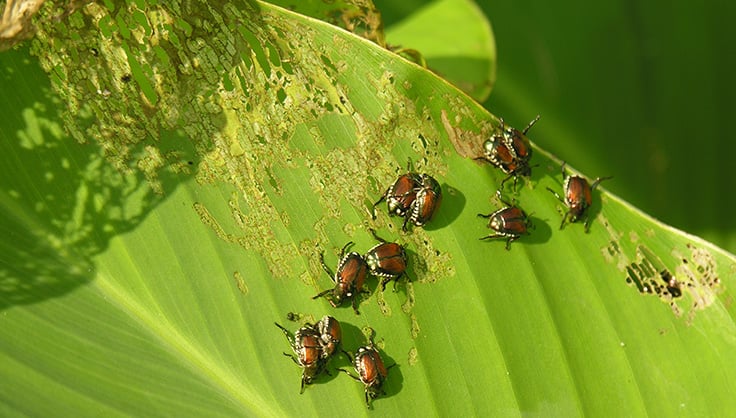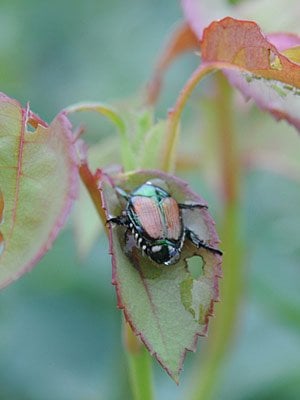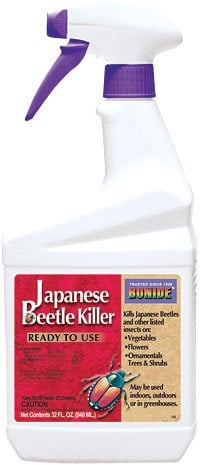How to Control Japanese Beetles

Japanese beetle damage is pretty easy to identify. Usually, the bugs can be caught in the act. The telltale signs of Japanese beetles include skeletonized leaves or total defoliation. Japanese beetles also love to eat rosebuds — from the inside out. Keep in mind that Japanese beetles are seldom found west of the Mississippi River, but chances are good that they're headed your way.
The beetles are strangely beautiful: roughly 3/8" long and 1/4" wide. They have shiny, metallic-green bodies and copper-colored wing covers.
Four Ways to Control Japanese Beetles
1. Play Defense
A multi-part attack is best. Start by spraying the affected plants with Japanese Beetle Killer (pyrethrin) or neem at the first sign of attack.
In addition to controlling Japanese beetles, Pyrethrin-based insecticides also controls cucumber beetles, fleas, cabbageworms, Colorado potato beetles, ticks, mosquitoes, and more. Pyrethrins are a class of chemicals found naturally in chrysanthemums — in fact, adding chrysanthemums strategically around your garden and house exterior can help repel insects. Synthetic, man-made chemicals called "pyrethroids" were created to mimic the insect-repelling characteristics of pyrethrins. Although they mimic a natural plant, note that there is nothing "organic" about pyrethrin-based insecticides. Pyrethrins break down quickly under sunlight and are generally low in toxicity to people. However they are extremely toxic to bees and aquatic organisms including fish, macroinvertebrates, and shellfish. For more information about pyrethrin-containing insecticides, please consult the National Pesticide Information Center.
Neem oil originates as an oil extracted from neem trees; when sprayed on plants, it reduces feeding. Scientists call it an antifeedant. Important: neem works best when applications begin at first sign of attack.
 A Japanese beetle, feasting on tender, new leaves of a rose bush. Photo: David Grist
A Japanese beetle, feasting on tender, new leaves of a rose bush. Photo: David Grist2. Hand Pick
Japanese beetles are slow. You can easily pick them off plants with your hands and toss them into a bucket of soapy water. Do it in the morning when the beetles are less alert.
3. Prevent
Although the following solutions won't provide immediate gratification, you will be better off next year. Beneficial nematodes kill the grubs that turn into Japanese beetles. Ideally, apply them in spring before the beetles emerge. The second half of this 1-2 prevention punch is Milky Spore, which also kills grubs. It takes a year or so to get established in your soil, but it keeps working for 10 years or more.
4. Trap
A Japanese beetle trap is recommended only if you have a large yard, and can place the trap away from your garden. If you have a small yard, you'll just be telling the beetles, "The party's at my house!" If you use a trap, put it out for a day or two at a time every couple of weeks.
Plants Most Susceptible to Japanese Beetle Damage
If you have these plants, monitor them closely:
- American Linden
- Crabapple
- Apple, Cherry, Plum, and other fruit trees
- Japanese maple
- Norway maple
- Rose
- Crape myrtle
- Pin oak
- Raspberries
- Birch
- Zinnias
- Basil
Why Neem Oil?
Not only does it control Japanese beetles in the heat of their feeding frenzy, it also controls: adelgids, wooly adelgids, sawflies, aphids, sawfly larvae, cabbage loopers, lacebugs, scale, cabbageworm, leafhoppers, chinch bugs, mealybugs, spider mites, crickets, earwigs, flea beetles, mole crickets, squash bugs, pear slugs, tent caterpillars, grasshoppers, pear psyllas, thrips, green stink bugs, whiteflies, psyllids, gypsy moth caterpillars, rose slugs, harlequin bugs, rust mites and other soft-bodied insects.
Neem can also be used on roses in a formulation called Rose Rx, which prevents diseases that plague roses: blackspot, powdery mildew, rust, scab, anthracnose and more.
Even if you use Milky Spore and beneficial nematodes, you can still get Japanese beetles. Yes, they're slow, but they can fly up to a mile for a good meal. Neem or pyrethrin-based sprays can control these outbreaks.
 Neem Oil works on a wide variety of pests including Japanese beetles, aphids, mites, whiteflies, flea beetles and earwigs.
Neem Oil works on a wide variety of pests including Japanese beetles, aphids, mites, whiteflies, flea beetles and earwigs.
Print this Article:
Get the Dirt
Stay up to date on new articles and advice. Please fill out the information below.


